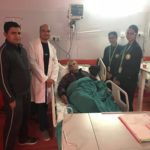New Delhi, October 26, 2017: World Stroke Day is observed on the 29th of October every year. This year the theme is ‘what is your reason for preventing a stroke?’ Stroke is one of the leading causes of death and disability in the world. According to the World Stroke Organisation, every year 6.5 million deaths occur due to stroke. One in six people are likely to suffer from a stroke. Every 4 minutes a person suffers from stroke, currently there are an estimated 26 million survivors of stroke.
Dr. Rima Khanna, Associate Consultant-Neurology, Fortis Hospital, Shalimar Bagh shares quick facts which help us understand stroke – the symptoms and risk factors associated with it
What is a stroke?
A stroke takes place when the blood supply to a part of the brain is cut off. Without blood, brain cells get damaged and die. The severity of stroke depends on which part of the brain is affected and how quickly the person is treated. A stroke can affect a person’s mobility, speech, ability to think, feel and analyse.
Warning Signs & Silent Symptoms of Stroke:
- Sudden confusion
- Sudden difficulty in speaking or understanding speech
- Sudden Weakness of one side of body
- Sudden difficulty seeing with one or both eyes
- Sudden Dizziness, loss of balance or coordination
- Sudden fainting or unconsciousness
- Sudden change in sensation on one side of body
Types of Strokes:
- Haemorrhagic Stroke: An artery may rupture and cause bleeding into the brain tissue , Also called a cerebral haemorrhage
- Ischaemic Stroke caused by atherosclerosis: An artery may become blocked by progressive thickening of its walls
- Ischaemic Stroke caused by embolism: A clot blocks an artery and prevents blood from getting into the parts of the brain.
Treatable Risk Factors:
- High Blood Pressure or hypertension: Hypertension can increase the risk of stroke by two fold. This is because it can narrow the blood vessels causing them to rupture or leak. It can also result in the formation of blood clots which further increase the risk of stroke.
- Smoking: It is known to cause stroke as it leads to increased blood pressure which can cause the blood to clot and additionally builds up fatty substance (blockage) in the main artery which provides blood to the brain.
- Diabetes: Diabetes doubles your risk of having a stroke and is a contributing factor for 20% of the strokes. High blood sugar in the blood can damage blood vessels making them harder, narrower and more likely to be blocked. If this happens in a blood vessel leading to the brain it could cause a stroke.
- High Levels of cholesterol: Low-density lipoprotein cholesterol (LDL) carries cholesterol (a fatty substance) through the blood which causes blockage. The build of plaque in the arteries makes it difficult for the blood to carry the oxygen to the brain.
- Lack of physical activity and obesity: Obesity and overweight are the primary risk factors for stroke for men and woman of all races. It increases the risk of stroke due to inflammation caused by excess fatty tissues. Waist Circumference and related ratios can better predict stroke than body mass index(BMI)
- Stress: One major factor which causes high blood pressure is stress. It causes the blood vessels to narrow and can increase chances of blood clots and heart attacks and stroke.
Understanding “Golden Hour” in stroke
It is imperative for a stroke patient to get to the hospital in the ‘Golden Period’ i.e. within first 4.5 hours of the stroke (the sooner the better). This is because clot busting medication will be effective if administered within 4.5 hours of stroke on set. For every minute in which the blood flow is not restored, nearly two million additional nerve cells die. Hence, it is important that patient should reach an equipped stroke centre as early as possible.
Caring for a stroke patient at home:
- Physiotherapy: If a stroke causes damage to the part of brain that controls movement one may experience weakness or paralysis on one side of the body. Physiotherapy is an important part of the rehabilitation process. The main focus of Physiotherapy is to move the legs and arms again and regain as much strength and movement as possible.
- Behavioural Treatment: A stroke patient might undergo behavioural problems like depression and anxiety. It is important to ensure that they feel encouraged and supported. Making them a part of a support group is one way to enable them to handle their emotions. Enabling them communicate with people who have similar conditions is important and effective.
- Medical Documentation: Ensuring that the patients’ medical needs are taken care of in an effective manner is very important. The medications and behavioural changes have to be monitored.
Stroke might be the beginning of an epidemic in India if left unattended. Inadequately controlled by Hypertension and Diabetes, poor lifestyle choices and lack of awareness are the major contributors to the rising numbers.







